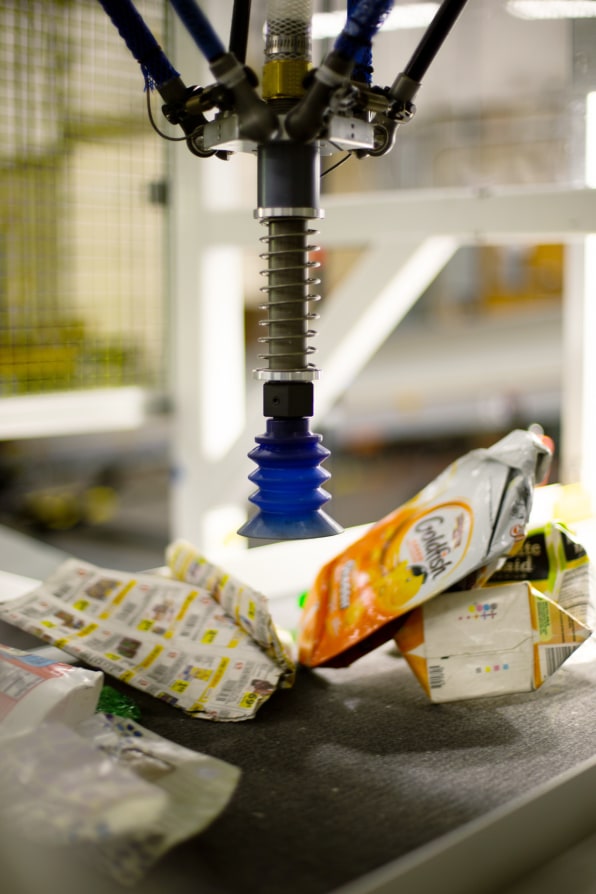[Photo: courtesy AMP Robotics]
BY ADELE PETERS
Source: www.fastcompany.com, November 2019
The global recycling system is collapsing largely because it’s been difficult for recyclers to accurately separate different materials. Robots can help.
Inside a sprawling recycling center in Florida, as bottles, cans, boxes, and other recyclables move down conveyor belts, 14 different robots use artificial intelligence to identify each material and automatically sort it, moving twice as quickly as humans doing the same job. The center, called Single Stream Recyclers, is one of the latest to install technology from Amp Robotics, a Colorado-based startup that wants to help the recycling industry deal with its current challenges.
“We think that this will be transformative technology for the recycling industry, because for the first time, you can see and understand all of these different consumer packaged goods, and if you can see and sense that and record what’s going on, that opens up all kinds of automation,” says Matanya Horowitz, founder and chief executive officer at AMP Robotics. The company announced today that it has raised $16 million in a series A round of funding led by Sequoia Capital, which is investing in the circular economy for the first time.

The recycling industry in the U.S. is still in crisis nearly two years after China banned imports of low-value recycling—a ban that made sense, since some shipments were so poorly sorted or contaminated with garbage that they were nearly worthless. American recycling infrastructure wasn’t working well, in part because it had previously been easy to outsource the quality challenges to China. As U.S. recyclers struggled to find buyers without China, some cities started sending some recyclables to landfills or incinerators; many cities have cut back on the types of material that they accept, or even canceled curbside recycling completely.
Now, new recycling infrastructure is being built in the U.S. to help fill the gap. But the challenge of sorting out high-value materials still remains. One piece of the problem is what happens at recycling bins, since consumers are often confused about what’s actually recyclable. The next problem is what happens at the centers that sort through truckloads of recycling waste from cities.

AMP’s robots can sort 80 items per minute, roughly twice as much as a human picker averages, and can do the work more accurately. The software that runs the robots uses machine learning to recognize each object. “We show the system literally millions of examples of different objects, and it figures out the different patterns in this data,” says Horowitz. “It begins to learn things like logos, different shapes, and textures.” A particular logo might be correlated with #1 plastic; a particular shape might be correlated with a cereal box.

Until now, most sorting facilities, called “material recovery facilities” or MRFs, have used equipment from the mining industry that can help identify materials by density or shape. But it’s an imprecise system, and a bale of paper might end up including plastic bottles or aluminum cans. Workers separating out waste manually can find those contaminants, but facilities now are often understaffed because the work is monotonous, smelly, and otherwise unpleasant.
It’s a good job for robots because it’s not really a job that humans want, and turnover is high. (For now, human workers work side by side with the robots, helping remove larger contaminants—like pieces of wood, or tricycles—that the robot can’t yet grab.) As the technology develops, the company says that the robots will get even faster. The equipment can be installed along with a facility’s existing machinery.
By sorting precisely, it’s possible to end up with high-value materials that a recycling facility can sell at a profit, even in today’s more complicated recycling market. It’s also possible to pull out materials that haven’t been commonly recycled in the past, like coffee cups, which use high-value paper but have been too difficult to sort. “We were able to teach the robots what coffee cups were, and they can separate them out in industrial volumes,” says Horowitz. “The recycling facilities, through a software update, had access to a new material stream and could sort them out and divert them from the landfill effectively.” The same technology can also be used to sort electronic waste and waste from the construction industry.
At the moment, only around 5% of municipal recycling facilities use robots to sort materials. Amp says that the cost of its system isn’t really an issue, since it rents out the equipment to facilities that can’t afford the capital expense, and those that buy the technology can get a return on investment fairly quickly, depending on the volumes they process and market prices. The next step to more adoption, Horowitz says, is for his company to use the success of early installations to convince more facilities that the technology works. The new round of funding will also help the company scale up.

